Key Takeaways
- Low-back pain is often caused by a dysfunction in the muscles and joints surrounding the low-back (it often has nothing to do with your spine!).
- Three of the most common dysfunctions are a “stuck” thoracic spine, a stiff quadratus lumborum muscle, or glute muscle that aren’t firing properly.
- Keep reading to learn 6 of the best exercises for low-back pain you can do in 10 minutes per day!
Modern medicine has a cure for nearly everything.
After all, it’s eradicated smallpox, eliminated malaria in most developed countries, and nearly put an end to polio.
It’s also created all kinds of pills, potions, and powders to treat ailments ranging from the common cold to cancer.
And yet, it still hasn’t come up with a cure for low-back pain.
In fact, low-back pain is the leading cause of disability worldwide, and nearly 80% of people will experience it at one time or another.
To make matters worse, most cases of low-back pain are chronic or recurring, and symptoms often come and go without rhyme or reason.
It affects the young and old, healthy and disabled, active and sedentary.
I’m a good example.
I’ve been an athlete my entire life, most recently transitioning from collegiate sports to lifting weights to keep myself healthy and motivated. I’ve also dealt with bouts of low-back pain throughout much of my athletic career, starting when I was around 20 years old.
I know how frustrating, confusing, and debilitating it can be.
Now for the good news.
While researchers still have many unanswered questions about low-back pain and no two cases are identical, there are some evidence-based exercises you can use to reduce your chances of developing low-back pain or get rid of it.
These exercises don’t just have a sound theoretical basis—they also work in the real world.
As a Doctor of Physical Therapy, I see patients every week who are dealing or have dealt with low-back pain, and I know some simple strategies that tend to help.
Of course, this article isn’t meant to diagnose or treat anyone, as there are hundreds of potential contributors to low-back pain. That said, I have identified three factors that seem to be common culprits.
What’s more, I’ve also experimented with many different stretches, exercises, and other strategies to fix and prevent low-back pain, but the six I describe in this article are the best exercises for low-back pain I’ve found yet.
So, if you want to learn what these three causes of low-back pain are, how to know if they’re affecting you, and what you can do to prevent and fix them, keep reading.
What Is Low-Back Pain?
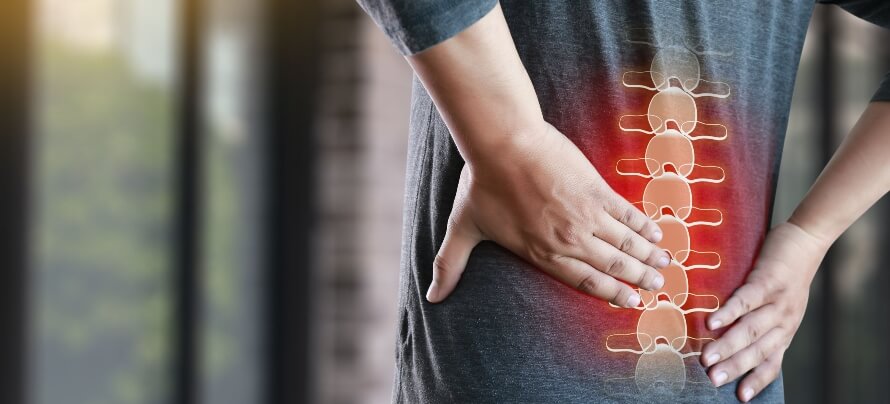
Well, the easy answer is, “You know it when you have it.”
That isn’t very helpful, obviously, so here’s a more precise definition:
Low-back pain is an acute, chronic (>12 weeks), or chronic recurring (comes and goes) condition presenting with pain roughly between your lowest rib and glutes.
Frequently, low-back pain is coupled with other symptoms such as radiating pain into the buttock and leg, numbness, trigger points, other spinal pain, etc.
3 of the Most Common Causes of Low-Back Pain
There are myriad reasons why you may be experiencing low-back pain.
From my clinical experience, these factors don’t usually present exclusively but rather as several dysfunctions acting together.
That said, there are common and overlapping dysfunctions that we as human beings can subject ourselves to. The good news is these issues are modifiable with healthy doses of education and know-how.
The three of the most common causes of low-back pain are:
- Your thoracic spine is stuck.
- You have an angry quadratus lumborum muscle.
- Your glutes aren’t firing.
Let’s take a closer look at each of these factors.
Low-Back Pain Cause #1: Your Thoracic Spine Is Stuck
The thoracic spine encompasses all vertebrae roughly from the base of the neck down to the narrowest portion of your abdomen. I usually just refer to these vertebrae as the “mid-back.”
“But wait,” you might be wondering, “the pain is in my low back, so why should I care about my thoracic spine?”
Well, you should care because dysfunctions in this portion of your spine often contribute to low-back pain.
A healthy thoracic spine should be very mobile. It should do quite a bit of bending forward, backward, rotating left, rotating right, and so on.
That’s what it should be able to do.
Now compare that description to what you see in your workplace, classroom, or coffee shop. How are people sitting? What do their backs look like?
Likely, you see a bunch of thoracic spines that are greatly rounded forward in an excessively “hunched” position.
Don’t get me wrong; this isn’t abnormal, technically speaking.
The thoracic spine has a naturally kyphotic curve, meaning it should be rounded forward. However, because of how much we sit all day, stare into our phones, etc. this position is often exaggerated and results in a thoracic spine that’s less mobile or “stuck.”
It doesn’t move as freely as it should, and this reduced range of motion can contribute to low-back pain.
Research looking at the biomechanical differences in the spine during standing and sitting shows that even in healthy subjects, the angle of thoracic kyphosis increased about 3 degrees while sitting, which doesn’t sound like a whole lot, but when most of us are staring at screens all day, that 3 degrees can turn into 10 degrees very quickly as we get tired.
Other research shows increased kyphosis is closely correlated with spinal pain among a group of office workers.
The point is this: prolonged sitting in a hunched posture can cause the thoracic spine to not move as well as it should. So, something must pick up its slack. I’m talking about its neighbor, the low back, which doesn’t and shouldn’t move as freely as the thoracic spine.
In other words, there’s an imbalance between the mobility of the thoracic and lumbar spine. Normally, the thoracic spine should do most of the moving and the lumbar spine should remain relatively imobile. If the thoracic spine can’t move as much as it would like to, though, then the low-back is forced to move more, which causes pain.
So, how do we fix this problem?
Here are two exercises that help restore thoracic extension and rotation—“unsticking” the spine, if you will.
I’ve used these with my patients and myself, and they usually produce a noticeable improvement.
1. Foam rolling into thoracic extension.
Here’s how to do this:
- Lie on a foam roller so that it touches your shoulder blades, supporting the weight of your head with your hands.
- Gently roll up and down your spine, never moving beyond the tops of your shoulder blades or onto your low back.
- Allow your spine to extend over the foam roller throughout this process.
2. Side lying thoracic rotation.
Here’s how to do this:
- Lie on your right side, and bring your thighs up so they form a right angle with your torso.
- Reach your arms out in front of you with hands together.
- Keeping your knees together, and both arms straight, lift your left arm up in an arc around the top of your head, keeping it in contact with or close to the ground, allowing your torso to rotate as you move your arm around your body. Continue moving your arm in this arc until your left shoulder blade contacts the floor.
- Reverse the motion, and repeat 10-15 times.
- Once you’re finished, flip over on your left side and repeat the same steps.
Low-Back Pain Cause #2: You Have an Angry Quadratus Lumborum Muscle
Holy syllables.
The quadratus lumborum (QL) is a muscle in the low-back that runs from the top of the hip bone to the vertebrae of the low-back and lowest rib.
Here’s what it looks like:
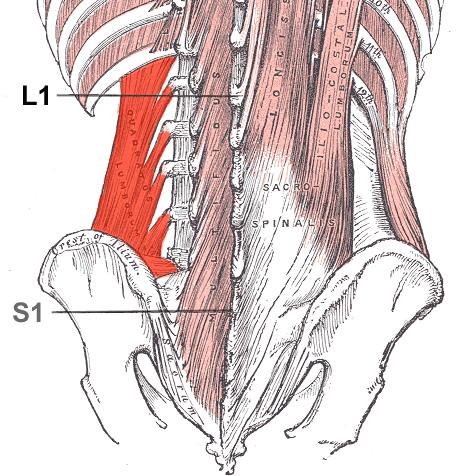
How many times have you been discussing back training and mentioned the QL?
Probably never, and I don’t blame you. This muscle actually lies underneath the much bulkier and prettier erector spinae muscles.
The QL is responsible for lateral flexion, or “side bending.” Additionally, it plays a large roll in hip hiking, which looks like this:
If you want to try this for yourself, stand up and raise either foot from the floor without bending at the hip or knee. Your foot only rises a couple inches, right? Well, that’s likely due to a good ole’ fashioned contraction of the QL.
So, what does the QL have to do with low-back pain?
A lot, in fact.
Remember how most people (likely including you) spend their day? Sitting.
When you sit in a normal office chair, there’s constant force pushing up on your pelvis, elevating your hip bones. This upward force from the chair is necessary to support your body weight, but it also does a good job of shortening the QL muscles. Over time, this can cause significant pain.
How about when you sit on the couch? You likely lean on one side or the other, causing one of the QLs to shorten and the other to lengthen.
Now, when I say “shorten” I don’t necessarily mean the muscles have shrunken and are permanently smaller. Instead, “shortening” in this case refers to the process by which a muscle over time becomes accustomed to a shorter range of motion than what it should be able to move through comfortably.
Humans are by nature creatures of habit. I know when I’m sitting down and watching The Office for the eighth time; I typically lean toward the right, causing my right QL to become tight and angry.
These positions can shorten one or both of our QL muscles over time, causing pain and sometimes muscle spasms.
Does any of this sound familiar?
In addition to the QL being tender to touch, it usually refers pain downward. That is, pain in the QL can often spread to other areas of the low-back and leg.
How far downward depends on the location of the tightness. Check out these graphics.
Do any of these red locations look familiar?
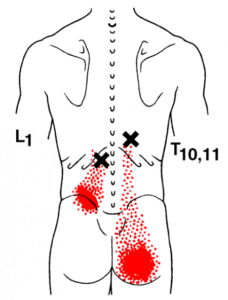
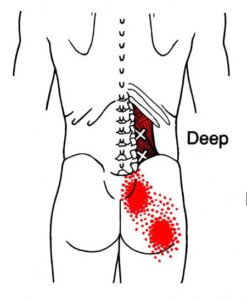
The X’s mark the spot where the pain originates, the red dots and blotches indicate where the pain refers to and is most severe.
So, what can you do about this?
Here is a stretch for the QL and a soft tissue technique to help release trigger points.
1. Quadratus Lumborum Stretch
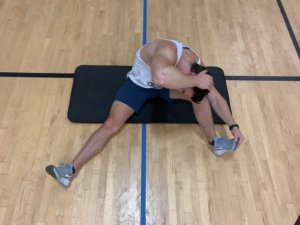
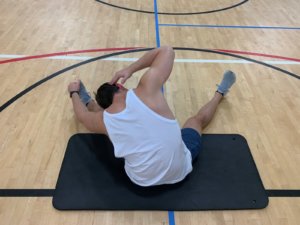
Here’s how to do it:
- Sit on the ground with legs spread apart.
- Bend your left knee slightly and grab your left foot.
- Using your right hand, touch your head behind your ear, and lower your head toward your left knee.
- Hold your head there for 30 to 60 seconds, then repeat with the opposite side of your body.
2. Quadratus Lumborum Flossing
Here’s how to do it:
- Lie on your right side, and place a tennis ball, battle rope, or barbell under the area where the QL is located.
- Support your body weight with your right elbow.
- Lift your right knee up to waist level (or as high as you can without pulling yourself out of position), and then straighten your right leg, pushing it as straight as possible.
- Repeat three to four times, then switch sides and repeat while lying on your left side.
Low-Back Pain Cause #3: Your Glutes Aren’t Firing
There are a thousand reasons why having strong glutes is important, and warding off low-back pain is one of them.
First, an anatomy lesson.
Each “cheek” of your butt has three different glute muscles.
- Gluteus Maximus
- Gluteus Medius
- Gluteus Minimus
Here’s what they look like:
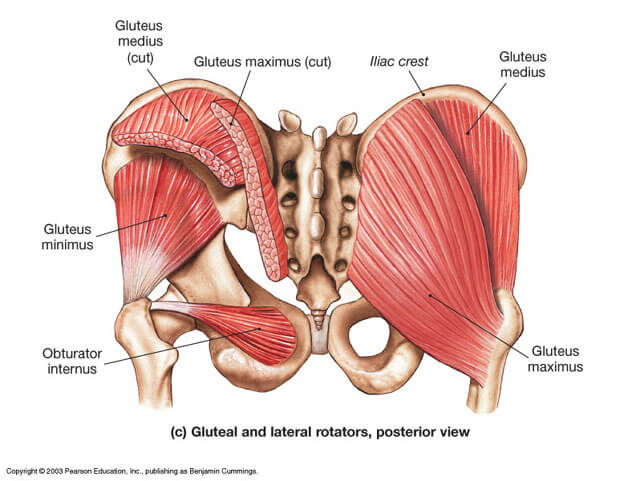
First, we have the gluteus maximus. As one of the largest and most powerful muscles in the body, this is the portion of your butt that probably comes to mind first. It has two main functions:
- Hip extension (moving the leg backward and behind you)
- Hip external rotation (turning your thigh outward from your midline)
The gluteus medius and gluteus minimus are located further out on the side of your hips and are appreciably smaller than their neighbor, the gluteus maximus, which is mostly on the back of your hips. These muscles share the same functions:
- Hip abduction (raising your leg to the side)
- Hip internal rotation (turning your leg inward toward your midline)
Why does this matter?
Well, glute weaknesses and imbalances can play a huge role in low-back pain for several reasons.
First, the glutes play a major role in keeping your back upright.
As human beings, we live our lives in an upright position. “Upright” isn’t some natural, default position for your skeleton though. Instead, a variety of muscles must continually contract and stabilize your spine to keep it erect.
Your glutes are largely responsible for maintaining this upright position. Have you ever seen someone walk and notice his or her hips are swinging side to side (unintentionally)?
What about the person standing at a concert that constantly shifts their weight from one foot to the other?
What’s likely happening is their glutes aren’t strong enough to keep their hips level as they walk, thus helping them maintain an upright position.
Luckily, there are several things you can do to correct these problems, which you’ll learn about in a moment.
Second, weak or uncoordinated glute muscles can interfere with proper technique when weightlifting.
For example, an ill-timed or weak gluteus medius and minimus can wreak all sorts of havoc during squats. Most of us know that when squatting, your knees shouldn’t bow inward toward one another. However, that sort of inward bowing can often be the result of weak glute muscles or firing glute muscles at the wrong times. Many studies agree.
While squatting, the gluteus medius and minimus should be flexing and relaxing at the appropriate times to keep the legs in their proper position and prevent the knees from caving in toward one another.
Poor glute timing during hip hinge movements can also cause issues. When I say “hip hinge,” I’m talking about a hip-driven movement in which the spine stays mostly neutral and knees slightly flexed such as stiff-legged deadlifts, good mornings, Romanian deadlifts, glute-ham raises, etc.
These lifts should be driven by glutes, the most powerful extensors of the hip. Extension occurs during the ascension phase of these lifts.
What often happens, though, is people use their back muscles to swing the weights up, taking tension off the glutes.
Instead, the glutes should be constantly lengthening while lowering weight to the floor and flexing while bringing the bar back up. You should feel tension in the glute muscles throughout the entire movement, while keeping your spine more or less neutral.
When I’m working with folks on hip hinging, especially those with low-back pain, I tell them to squeeze the glutes on the way up. “Try to give yourself a wedgie, I might say.” Maybe that’s weird . . . but it’s effective.
Finally, another common cause of weak glutes is neglecting to train them in all planes of motion.
You see, your body can move in multiple different directions.
Moving in the sagittal plane simply means moving your body either forward or backward. This is the plane of motion we operate in during work, walking, squatting, and yes . . . curling.
Earlier, I mentioned the actions of the gluteus maximus, medius, and minimus. The gluteus maximus is the only muscle that has a single sagittal plane function (hip extension), but the rest are either in the transverse (rotary) or coronal (sidewise) planes.
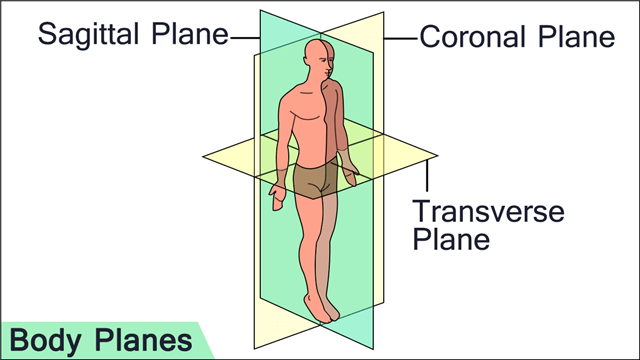
Chronically neglecting the frontal and transverse planes in both our daily lives and especially our workouts can cause your glutes to become weak and lazy.
What ensues is poor hip stabilization which can eventually manifest as low-back pain.
Here are two exercises to incorporate into your warm-up or cool-down routine to make sure you have an appropriate mind-muscle connection with your glutes in multiple planes.
1. Frog Bridge

Here’s how to do it:
- Begin by lying on your back with knees up, feet a few inches in front of your butt and turned inward touching one another, and your arms extended straight in front of your face toward the ceiling.
- Flex your abs slightly until you feel the small of your back contact the floor
- Lift the hips toward the ceiling, focusing on contracting your glutes.
- Lower your hips back to the floor in a slow, controlled manner.
- Repeat 10 to 15 times.
2. Clamshell
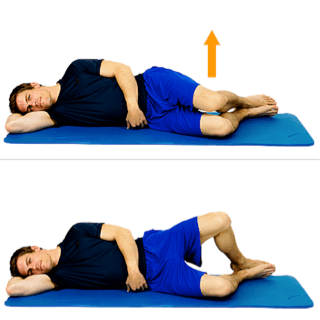
Here’s how to do it:
- Lie on your right side and draw your knees slightly toward your torso, so they’re at about a 45-degree angle.
- Keeping your feet together, lift your left knee toward the ceiling, contracting your glutes.
- Repeat 10 to 15 times, then flip over and repeat on your left side.
Neither of these exercises is “difficult.” They won’t make you work up a sweat or lose your breath, and they won’t slap extra muscle on your butt.
What they will do, though, is improve your glute strength and activation during everyday life and while doing key exercises like the squat and deadlift.
And as you learned a moment ago, strengthening your glutes helps reduce low-back pain by keeping your hips and pelvis in healthier positions throughout the day, decreasing excess movement in the low-back, and adding stability to movement in all planes.
The Bottom Line on Low Back Pain
Low-back pain is one of the most common afflictions for both athletes and sedentary desk jockeys.
Although low-back pain can seem to come and go without any explanation, I have identified a few common denominators that often seem to accompany low-back pain in my patients.
They are:
- Your upper thoracic spine is stuck.
- You have an angry quadratus lumborum muscle.
- Your glutes aren’t firing
Luckily, all three of these problems are often easy to fix using a handful of simple stretches and exercises that only take a few minutes per day.
Try them out and see if they help you!
What do you think of these six exercises for low-back pain? Have anything else to add? Lemme know in the comments below!
Scientific References +
- Lubahn AJ, Kernozek TW, Tyson TL, Merkitch KW, Reutemann P, Chestnut JM. Hip muscle activation and knee frontal plane motion during weight bearing therapeutic exercises. Int J Sports Phys Ther. 2011;6(2):92-103. http://www.ncbi.nlm.nih.gov/pubmed/21713231. Accessed December 23, 2019.
- Fathollahnejad K, Letafatkar A, Hadadnezhad M. The effect of manual therapy and stabilizing exercises on forward head and rounded shoulder postures: a six-week intervention with a one-month follow-up study. BMC Musculoskelet Disord. 2019;20(1):86. doi:10.1186/s12891-019-2438-y
- Pierce KE, Horn SR, Jain D, et al. The impact of adult thoracolumbar spinal deformities on standing to sitting regional and segmental reciprocal alignment. Int J Spine Surg. 2019;13(4):308-316. doi:10.14444/6042
- Andersson GBJ. Epidemiological features of chronic low-back pain. Lancet. 1999;354(9178):581-585. doi:10.1016/S0140-6736(99)01312-4
- Hartvigsen J, Hancock MJ, Kongsted A, et al. What low back pain is and why we need to pay attention. Lancet. 2018;391(10137):2356-2367. doi:10.1016/S0140-6736(18)30480-X










